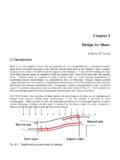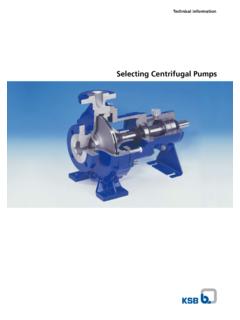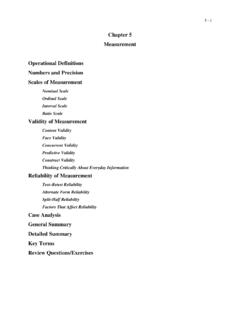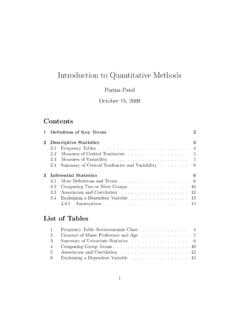Transcription of The Time Value of Money (contd.) - MIT OpenCourseWare
1 1 The Time Value of Money (contd.) February 11, 2004 Time Value Equivalence Factors(Discrete compounding, discrete payments)Factor NameFactor NotationFormulaCash Flow DiagramFuture worth factor(compoundamount factor)(F/P, i, N)F=P(1+i)NPresent worthfactor(P/F, i, N)P=F(1+i)-NUniform seriescompound amountfactor (aka future-worth-of-an-annuity factor)(F/A, i, N) F=A(1+i)N-1i Sinking fund factor(A/F, i, N) A=Fi(1+i)N-1 F _____ A A A A A APresent worth ofan annuity factor(P/A, i, N) P=A(1+i)N-1i(1+i)N Capital recoveryfactor(A/P, i, N)
2 A=Pi(1+i)N(1+i)N-1 A A A A APFP2 Homework problem typical bank offers you a Visa card that charges interest on unpaid balances at a month compounded monthly. This means that the nominal interest rate (annualpercentage) rate for this account is A and the effective annual interest rate is B. Supposeyour beginning balance was $500 and you make only the required minimum monthlypayment (payable at the end of each month) of $20 for the next 3 months. If you madeno new purchases with this card during this period, your unpaid balance will be C at theend of the 3 months.
3 What are the values of A,B, and C?A = ( )(12) = 18%B = (1+ )12-1 = do this problem we construct a cash-flow diagramC = -500 (F/P, , 3) + 20 (F/A, ,3) = -$ problem that $1,000 is placed in a bank account at the end of each quarter over the next10 years. Determine the total accumulated Value (future worth) at the end of the 10years where the interest rate is 8% compounded quarterly F=A1+iq()N-1iq =$1,0001+ =$60,4023 Example -- Valuation of Bonds Bonds are sold by organizations to raise Money The bond represents a debt that the organization owes to the bondholder (nota share of ownership) Bonds typically bear interest semi-annually or quarterly, and are redeemablefor a specified maturity Value (also known as the face Value ) at a givenmaturity date.
4 Interest is paid in the form of regular premiums . The flow of premiumsconstitutes an annuity, A, whereA = (face Value ) x (bond rate) Bonds can be bought and sold on the open market before they reach maturity The Value (price) of a bond at a given point in time is equal to the presentworth of the remaining premium payments plus the present worth of theredemption payment ( , the face Value )Example -- Valuation of Bonds (contd.) Consider a 10-year treasury bond with a face Value of$5000 and a bond rate of 8 percent, payable quarterly: Premium payments of $5000 x ( ) = $100 occur four timesper year5000100010 PPresent worth at time zero P=A (P/A,r/4,40)+F(P/F,r/4,40)where A = 100, F = 5000, and r = 8%and using our formulae, we have P=A(1+i)N-1i(1+i)N +F1(1+i)N andsinceA=Fiwe haveP=F4 Another example See: What Exactly Is a Bond?
5 What exactly is the mistake in this applet?General bond valuation problemLet:Z = face, or par, valueC = redemption or disposal price (usually equal to Z)r = bond rate ( nominal interest) per period ( coupon )N = number of periods before redemptioni = yield to maturity of bond = total return on bond at a given purchase priceVN= Value (price) of the bond N interest periods before redemptionThe price of the bond is equal to the present worth of the future stream of payments paid by theborrower to the bondholder. This consists of (1) the series of periodic interest payments, and (2) theredemption Value of the bond at = C (P/F, i%, N) + rZ (P/A, i%, N)Note the difference between the coupon rate, r, and the yield rate i.
6 The coupon rate r is fixed for agiven bond, but the yield i depends on the bond purchase price. The desired yield is determined by therate of interest in the economy. If the general interest rate goes up, the yield required by bondinvestors will also go up, and hence the bond price today will the current price of a 10-year bond paying 6% per year (payable semi-annually) that is redeemable at par Value , if the purchaser requires an effectiveannual yield of 10% per year. The par Value of the bond is $ = 10 x 2 = 20 periodsr = 6%/2 = 3% per periodYield i per semi-annual period given by (1+i)2 = 1+ > i = = per semi-annual periodC = Z = $1000VN = $1000 (P/F, , 20) + $ (P/A, , 20) = + = $ problemSuppose you have the choice of investing in (1) a zero-coupon bond that costs $ , pays nothing during its life, and then pays $1,000 after 5 years or (2) a municipalbond that costs $1,000 today, pays $67 semiannually, and matures at the end of the 5years.
7 Which bond would provide the higher yield to maturity (or return on yourinvestment).Draw the cash flow diagram for each option:Return on investment in this case, i, is given by: +1000(1+i)10=0where i is the interest rate per half-year period1000 Option problem (contd.)Option IIReturn on investment, j, in this case is given by -1000+67(P/A,j%,10)+1000(P/F,j%,10)=0100 01000etcEffect of inflation on bond Value Inflation causes the purchasing power of Money to decline Note the difference between the earning power and thepurchasing power of funds See: The effect of inflation on the Value of bond income (Note -- same mistake on total present Value as before.)
8 7 Continuous compounding For the case of m compounding periods per year and nominal annual interest rate,r, the effective annual interest rate ia is given by: ia = (1 + r/m)m - 1 In the limiting case of continuous compounding ia=m lim(1+rm)m-1 Writingi=rmia=i 0lim(1+i)ri-1=er-1orr=ln(1+ia)Effective interest rates, ia, for various nominal rates,r, and compounding frequencies, mEffective rate ia for nominal rate ofCompoundingfrequencyCompoundingperiods peryear,m6%8%10%12%15%24% Compounding, Discrete Cash Flows( nominal annual interest rate r, continuously compounded, N periods)To FindGivenFactor NameFactor SymbolFactor formulaFPFuture Worth Factor*(F/P, r%, N)F = P(erN)PFPresent Worth Factor(P/F, r%, N)P=F(e-rN)
9 FAFuture Worth of anannuity factor(F/A, r%, N)F=AerN-1er-1 AFSinking Fund Factor(A/F, r%, N)A=Per-1erN-1 PAPresent Worth of anannuity Factor(P/A, r%, N)P=AerN-1erN(er-1) APCapital Recovery Factor(A/P, r%, N)A=PerN(er-1)erN-1 Example:You need $25,000 immediately in order to make a downpayment on a new home. Suppose that you can borrow themoney from your insurance company. You will be requiredto repay the loan in equal payments, made every 6 monthsover the next 8 years. The nominal interest rate beingcharged is 7% compounded continuously. What is theamount of each payment?
10 9 Another example: Discrete compounding & discrete cashflows, but the compounding and payment periods don tcoincide(From PSB:) Find the present worth of a series of quarterlypayments of $1000 extending over 5 years, if the nominalinterest rate is 8%, compounded cash flows, continuous compoundingIn many applications, cash flows are also essentially continuous (or it is convenient totreat them as such). We need to develop time Value factors equivalent to those we haveobtained for discrete cash X = continuous rate of flow of cash over a period (in units of , , $/yr)Assume also: continuous compounding at a nominal rate of r%/yr.


















